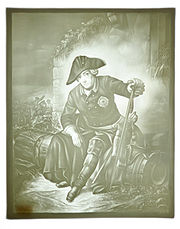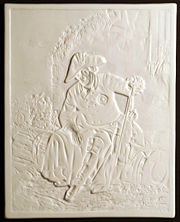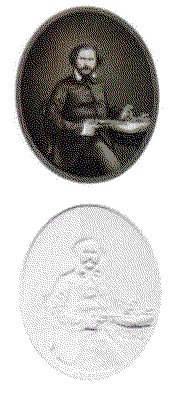
Lithophane
Encyclopedia

- For the moth genus, see Lithophane (moth)Lithophane (moth)Lithophane is a genus of moths of the Noctuidae family.-Species:* Lithophane abita Brou & Lafontaine, 2009* Lithophane adipel Benjamin, 1936* Lithophane alaina Boursin, 1957* Lithophane amanda...
A lithophane (or lithopane or French: lithophanie) is an etched or molded artwork in thin very translucent porcelain
Porcelain
Porcelain is a ceramic material made by heating raw materials, generally including clay in the form of kaolin, in a kiln to temperatures between and...
that can only be seen clearly when back lit with a light source. It is a design or scene in intaglio that appears "en grisaille" (in gray) tones.
A lithophane presents a three dimensional image - completely different from two dimensional engraving
Engraving
Engraving is the practice of incising a design on to a hard, usually flat surface, by cutting grooves into it. The result may be a decorated object in itself, as when silver, gold, steel, or glass are engraved, or may provide an intaglio printing plate, of copper or another metal, for printing...
s and daguerreotype
Daguerreotype
The daguerreotype was the first commercially successful photographic process. The image is a direct positive made in the camera on a silvered copper plate....
s that are "flat". The images change characteristics depending on the light source behind them. Window lithophane panel scenes change throughout the day depending upon the amount of sunlight. The varying lightsource is what makes lithophanes more interesting to the viewer than two dimensional pictures.
The word "lithophane" derives from Greek "litho", which is from "lithos" which means stone or rock, and "phainein" meaning "to cause to appear" or "to cause to appear suddenly". From this is derived a meaning for lithophane of "light in stone" or to "appear in stone" as the three dimensional image appears suddendly when lit with a back light source.
European lithophanes were first produced nearly at the same time in France, Germany, Prussia, and England around the later part of the 1820s. Many times historians credit Baron Paul de Bourging (1791–1864) with inventing the process "email ombrant" (pottery decorating) of lithophanes in 1827 in France. Robert Griffith Jones acquired Bourging's rights in 1828 and licensed out to English factories to make them. The English factories sometimes used the name "lithophane" for specimens of ordinary "email ombrant." Some say however it was Georg Friedrich Christoph (1781–1848) of Prussia that actually perfected the true lithophane process in 1828. Others say the technique was developed in Berlin and other parts of Germany by such manufacturers as Königlichen Porzellan-Manufaktur and Porzellanmanufactur. This is why sometimes lithophanes are referred to as "Berlin transparency." There is a well known mark of Ad'T' on lithophanes from Rubles, near Melun
Melun
Melun is a commune in the Seine-et-Marne department in the Île-de-France region in north-central France. Located in the south-eastern suburbs of Paris, Melun is the capital of the department, as the seat of an arrondissement...
in France. It is thought to be the mark of Baron A. de Tremblay, however some scholars on the subject think he only made earthenware
Earthenware
Earthenware is a common ceramic material, which is used extensively for pottery tableware and decorative objects.-Types of earthenware:Although body formulations vary between countries and even between individual makers, a generic composition is 25% ball clay, 28% kaolin, 32% quartz, and 15%...
and not true lithophanes and the mark belongs to a yet unknown source.

Tang Dynasty
The Tang Dynasty was an imperial dynasty of China preceded by the Sui Dynasty and followed by the Five Dynasties and Ten Kingdoms Period. It was founded by the Li family, who seized power during the decline and collapse of the Sui Empire...
. According to the scholar R. L. Hobson during the Ming Dynasty
Ming Dynasty
The Ming Dynasty, also Empire of the Great Ming, was the ruling dynasty of China from 1368 to 1644, following the collapse of the Mongol-led Yuan Dynasty. The Ming, "one of the greatest eras of orderly government and social stability in human history", was the last dynasty in China ruled by ethnic...
the Chinese produced bowls "as thin as paper" with secret decorations in them. According to W. Hodgson she describes some Chinese biscuit porcelains as looking like "little screens with landscapes in relief" which resemble white porcelian that is obtained in Switzerland. Other potential precursors to the European lithophanes come from the Chinese Song Dynasty
Song Dynasty
The Song Dynasty was a ruling dynasty in China between 960 and 1279; it succeeded the Five Dynasties and Ten Kingdoms Period, and was followed by the Yuan Dynasty. It was the first government in world history to issue banknotes or paper money, and the first Chinese government to establish a...
. Qingbal wares had their translucency with carved and molded designs of flowers, fish, and birds. Japanese lithophane tea sets are referred to as Dragonware and were popular for GI trading in Japan during World War II.
In the early part of the 20th century many lithophane investigators were making connections between the European 18th and 19th century ceramics and the Chinese porcelains. In France they used the term "Blanc de Chine" in the 18th century to designate a highly translucent Chinese porcelain. Porcelain factories in France, Germany and England mimicked the Chinese "Blanc de Chine" in the seventeenth and eighteen centuries. These same factories then started to make lithophanes in the early part of the 19th century. The technical and aesthetic inspirations for European lithophanes can be seen coming from Chinese works, however the exact relationship between the two remains elusive to this day. The missing link is a definite known lithophane plaque produced anywhere in China prior to 1800.
Lithophanes were made by specialized European craftspeople beginning as an image carved in warm wax on a glass plate. This was then backlit and carved. Sometimes the carving table was near a window and had a mirror below the table to provide constant light for carving. A modeler would duplicate the image on a flat wax plate carving relief and intaglio. Where the wax was carved thinnest more would shine through. Of course where the wax was carved thickest then there was less light shone through.
A plaster gypsum
Gypsum
Gypsum is a very soft sulfate mineral composed of calcium sulfate dihydrate, with the chemical formula CaSO4·2H2O. It is found in alabaster, a decorative stone used in Ancient Egypt. It is the second softest mineral on the Mohs Hardness Scale...
mold was cast from the wax. It was sometimes cast in metal for the production of multiple molds. The casts were removed from the molds and then fired to about 2300 degrees Fahrenheit. The porcelain would include around 66% kaolin, 30% feldspar
Feldspar
Feldspars are a group of rock-forming tectosilicate minerals which make up as much as 60% of the Earth's crust....
and 4% soapstone
Soapstone
Soapstone is a metamorphic rock, a talc-schist. It is largely composed of the mineral talc and is thus rich in magnesium. It is produced by dynamothermal metamorphism and metasomatism, which occurs in the areas where tectonic plates are subducted, changing rocks by heat and pressure, with influx...
. It turned out that up to about 60% of the porcelains would warp or crack in the kiln causing them to become useless. Finished lithophanes are somewhere between one sixteenth of an inch thin to almost a quarter inch (1.5 to 6mm) thick.
Lithophanes were produced in Austria, Belgium, Bohemia, Czechoslovakia, Denmark, England, France, Germany, Ireland, Italy, Norway, Portugal, Russia, Sweden, and Wales in the 19th century. Lithophanes by the hundreds of thousands were made in the middle of the eighteen hundreds by such firms as Wedgwood in England, Meissen in Dresden, and Belleek in Ireland. Lithophanes were produced then in the United States as well, however not nearly as much as in Europe. Popular subjects of lithophanes were religious themes, portraits, genre scenes, literature ideas such as stories from the Bible, and masterpieces. Some lithophanes even commemorated events such as the opening of the Eiffel Tower in 1889.

According to Henry Barnard
Henry Barnard
Henry Barnard was an American educationalist and reformer.-Biography:...
, Samuel Colt
Samuel Colt
Samuel Colt was an American inventor and industrialist. He was the founder of Colt's Patent Fire-Arms Manufacturing Company , and is widely credited with popularizing the revolver. Colt's innovative contributions to the weapons industry have been described by arms historian James E...
's first biographer, Colt ordered and had installed on his new home ("Armsmear
Armsmear
Armsmear , also known as the Samuel Colt Home, is a historic house located at Hartford, Connecticut. It was the family home of firearm manufacturer Samuel Colt and is now a National Historic Landmark....
") in Hartford, Connecticut
Hartford, Connecticut
Hartford is the capital of the U.S. state of Connecticut. The seat of Hartford County until Connecticut disbanded county government in 1960, it is the second most populous city on New England's largest river, the Connecticut River. As of the 2010 Census, Hartford's population was 124,775, making...
dozens of lithophanes he purchased in Berlin in 1855 and 1856. Colt probably got the idea from the 1851 Great (Crystal Palace) Exhibition in London or the New York Great Exhibition of 1853 or in a Prussia visit in 1854. Scenic views and portraits were for the public and private rooms of Colt's wife. Inspirational panes were for the windows of Colt's upstairs bedroom. Lithophanes of humorous nature were put in the windows of Colt's billiard room of his new home. One of particular interest was of the Battle of Trafalgar
Battle of Trafalgar
The Battle of Trafalgar was a sea battle fought between the British Royal Navy and the combined fleets of the French Navy and Spanish Navy, during the War of the Third Coalition of the Napoleonic Wars ....
. Others were of Stolzenfels Castle
Stolzenfels Castle
Stolzenfels Castle is a castle near Koblenz on the Rhine, Germany.Finished in 1259, Stolzenfels was used to protect the toll station at the Rhine, where the ships, back then were the main transport for goods, had to stop and pay toll...
on the Rhine River and a view of Koblenz
Koblenz
Koblenz is a German city situated on both banks of the Rhine at its confluence with the Moselle, where the Deutsches Eck and its monument are situated.As Koblenz was one of the military posts established by Drusus about 8 BC, the...
. Barnard described the lithophanes as "a veritable art gallery." A photograph of Armsmear taken between 1857 and 1861 shows over one hundred lithophanes. A photograph of 1907 shows the lithophanes of Armsmear still in place. Many of Colts surviving lithophanes are currently at the Wadsworth Atheneum
Wadsworth Atheneum
The Wadsworth Atheneum is the oldest public art museum in the United States, with significant holdings of French and American Impressionist paintings, Hudson River School landscapes, modernist masterpieces and contemporary works, as well as extensive holdings in early American furniture and...
Museum of Art.
Samuel Colt had 111 lithophanes made of his likeness from a photograph for wide distribution in 1855. In this lithophane portrait he is sitting at a small desk holding a "Belt Pistol" in his right hand and has a directional compass in his left hand. One of these he sent to Senator Thomas J. Rusk who responded in a letter of 3 January 1856 when he received it,
Additional
Additional reference pertaining to Samuel Colts lithophanes are located at the Connecticut Historical SocietyConnecticut Historical Society
The Connecticut Historical Society is the official state historical society of Connecticut. Established in Hartford in 1825, the CHS is one of the oldest historical societies in the nation....
- Samuel Colt papers, in particular box 7.

